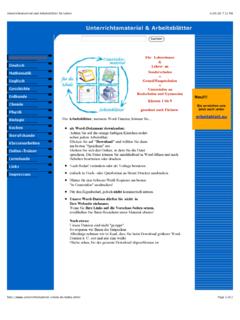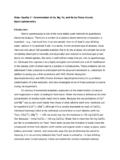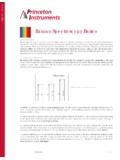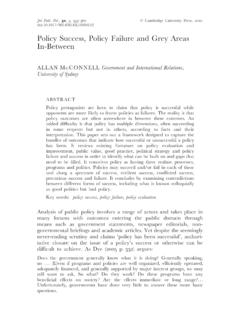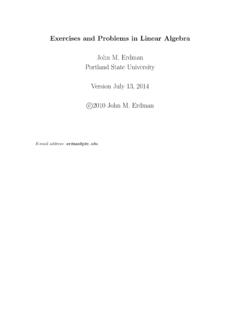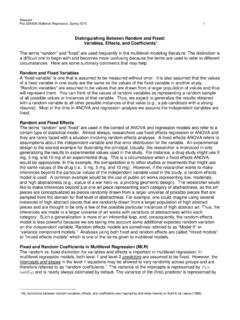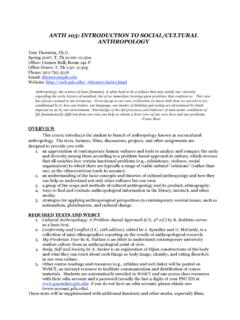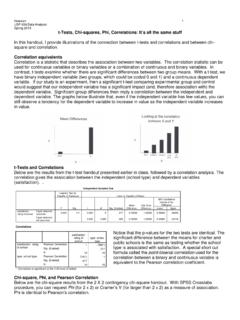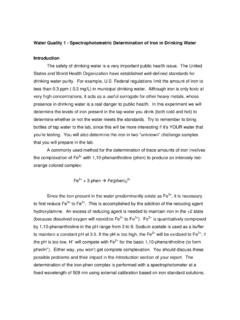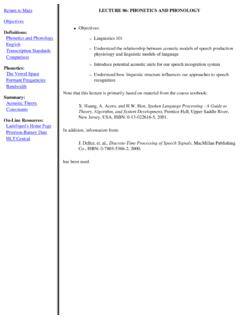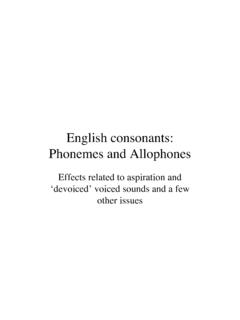Transcription of Phonology W12 HW2 Answers - Portland State University
1 Phonology HW2 Name: Answers Part I. Consider the following data based on Chatino, a language of Mexico. This language contains voiced and voiceless vowels. (Voiceless vowels sound whispery. ) Voiceless vowels are indicated with a small circle under the vowel (like voiceless liquids and glides), , [a ], [u ]. The data have been modified to simplify this problem. Assume phonetic transcription. Consider [ ] to be a voiceless glottal stop (a consonant). a) ka ta you will bathe j) siju juice b) ki fire k) sula open! c) ku su wa you will send l) tije stomach d) se e place m) la a side e) i sad n) lo o where f) ta a fiesta o) ndiki you are burning g) ti hi water p) u i tomato h) tu wa mouth q) ki su avocado i) kino sandal r) ha grass mat 1. For each of the following pairs of vowels, offer an analysis to support either separate phonemes or allophones of the same phoneme: [u ] and [u]; [ i ] and [i]; [a ] and [a]. There are no minimal pairs for the sounds involved.
2 Based on the distribution of data (show data, State that [u ] occurs between voiceless consonants (obstruents) and [u] occurs elsewhere), these sounds are in complementary distribution. Therefore, they are allophones of the same phoneme. Because the distribution is more varied ( , there are more environments, it is less predictable) for [u], this is selected as the phoneme. Show phonological organization tree (my term). The same for /i/ and for /a/ [sorry about the typeo in (m) above!]. 2. Knowing what we know about sounds behaving as a natural class, what can we suggest about [e ] and [e]? Then, write a rule using prose that describes what is happening in this language with respect to these sounds (use natural classes if possible). Also, what articulatory process seems to be at work here? (That is, can we support our analysis in 1 with phonetic-based motivations?) Since [i], [u] and [a] do not share any phonetic properties, we can group them into the natural class of vowels.
3 Therefore, we expect that the same distribution will apply for [e]. This leads to the general rule that in this language, based on these data, vowels become voiceless between voiceless consonants (obstruents). This is further supported because this allophonic variation is an example of voicing assimilation. 3. Now, support your above analysis in #1 by showing how another hypothesis is less elegant. (Try to offer another analysis of the data and demonstrate why it is a less-supportable analysis than in #1.) Remember that analyses should be elegant, which means as simple as possible but including all the necessary information to account for the data. If the voiceless vowel is selected as the phoneme, then we would need the following rules to derive the correct surface forms to match the data: voiceless vowels become voiced word finally voiceless vowels become voiced preceding a voiced consonant voiceless vowels become voiced following a voiced consonant Since the first analysis only needs 1 rule to predict the correct surface forms, it is more elegant/optimal/supportable.
4 Furthermore, voiceless vowels becoming voiced word finally or preceding/following a voiced consonant and not between voiced consonants is not phonetically motivated. 4. Write the Chatino phonemic forms (Underlying Representation) for the following: a) [ i ] sad / i / b) [tu wa] mouth /tu wa/ c) [la a] side /la a/ d) [ndiki] you are burning /ndiki/ 5. Write the Chatino phonetic form (Phonetic/Surface Representation) for the following: Part II. Consider the following data based on Greek. The data have been modified to simplify this problem. Assume phonetic transcription. a) kano do f) kufeta bonbons b) xali plight g) xrima money c) xori dances h) xano lose d) krima shame i) kali charms e) xufta handful j) kori daughter 1. Can you identify any phonemes in the language? If so, what are they and provide support for your answer. If not, explain why not. /k/ and /x/ are separate phonemes as demonstrated by minimal pairs: a-h, b-i, c-j, d-g and the near minimal pair e-f.
5 / aketudi/ [ a ke tudi] The following data are from Sindhi (spoken in India and Pakistan). Sindhi Gloss Sindhi Gloss 1. [p nu] leaf 7. [t ru] bottom 2. [v d!"u] opportunity 8. [k# to] sour 3. [ eki] suspicious 9. [b d!"u] run 4. [ do] dull 10. [b nu] forest 5. [d ru] door 11. [b t! u] be safe 6. [p# nu] snake hood 12. [d!" d!"u] judge 2. Can you identify any phonemes in the language? If so, what are they and provide support for your answer. If not, explain why not. Based on the minimal set: 1-6-10, /p/, /ph/ and /b/ are separate phonemes Based on the minimal set: 2-9-12, /v/, /b/ and /d!"/ are separate phonemes Based on the minimal pairs: 5-7, /t/ and /d/ are separate phonemes Based on the minimal set: 9-10-11, /n/, /t! / and /d!"/ are separate phonemes Based on the near minimal pairs: 4-8, /k#/ and / / are likely to belong to separate phonemes (same environment so not in complementary distribution) The probable phonemes in this language from these data are: labial alveolar palatoalveolar velar stops /p/ /b/ /t/ /d/ / / aspirated stops /ph/ /k#/ fricatives /v/ affricates /t!
6 / /d!"/ nasals /n/ Based on these data, it is difficult to prove that these sounds are the phonemes themselves or that they are allophones of separate phonemes. Until further data are analyzed, it is assumed that these sounds are separate phonemes. 3. Thinking about Sindhi Phonology regarding voiceless stops, how does it compare to the Phonology of english regarding voiceless stops? Remember, Phonology has to do with what sounds are produced in a language as well as how they are organized. In Sindhi, /ph/, /p/ and /b/ are separate phonemes. In english , /p/ and /b/ are separate phonemes, and [ph] is an allophone of /p/. Therefore, both languages have the same 3 sounds (same phonetics ), but they are organized differently (different Phonology ).
